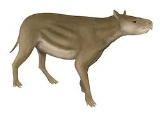
Heptodon
Encyclopedia
Heptodon is an extinct genus
of tapir
-type herbivore
of the family
Helaletidae endemic to North America
during the Eocene
epoch. It lived from 55.4—48.6 mya, existing for approximately .
by Colbert (2005). M. W. Colbert. 2005.
s. The shape of the skull suggests that it probably lacked the characteristic tapir trunk. Instead it probably had a slightly elongated, fleshy upper lip, like its relative Helatetes.
A single specimen was examined by M. Mendoza, C. M. Janis, and P. Palmqvist for body mass. It was estimated to have a weight of 15.5 kg (34.2 lb).
Genus
In biology, a genus is a low-level taxonomic rank used in the biological classification of living and fossil organisms, which is an example of definition by genus and differentia...
of tapir
Tapir
A Tapir is a large browsing mammal, similar in shape to a pig, with a short, prehensile snout. Tapirs inhabit jungle and forest regions of South America, Central America, and Southeast Asia. There are four species of Tapirs: the Brazilian Tapir, the Malayan Tapir, Baird's Tapir and the Mountain...
-type herbivore
Herbivore
Herbivores are organisms that are anatomically and physiologically adapted to eat plant-based foods. Herbivory is a form of consumption in which an organism principally eats autotrophs such as plants, algae and photosynthesizing bacteria. More generally, organisms that feed on autotrophs in...
of the family
Family (biology)
In biological classification, family is* a taxonomic rank. Other well-known ranks are life, domain, kingdom, phylum, class, order, genus, and species, with family fitting between order and genus. As for the other well-known ranks, there is the option of an immediately lower rank, indicated by the...
Helaletidae endemic to North America
North America
North America is a continent wholly within the Northern Hemisphere and almost wholly within the Western Hemisphere. It is also considered a northern subcontinent of the Americas...
during the Eocene
Eocene
The Eocene Epoch, lasting from about 56 to 34 million years ago , is a major division of the geologic timescale and the second epoch of the Paleogene Period in the Cenozoic Era. The Eocene spans the time from the end of the Palaeocene Epoch to the beginning of the Oligocene Epoch. The start of the...
epoch. It lived from 55.4—48.6 mya, existing for approximately .
Taxonomy
Heptodon was named by Cope (1882). It was considered paraphyletic by Colbert (2005). It was assigned to Helaletinae by Radinsky (1966); to Ceratomorpha by Cope (1882) and Colbert and Schoch (1998); to Heptodontidae by Holbrook (1999); and to TapiroideaTapiroidea
Tapiroidea is a superfamily of perissodactyls which includes the modern Tapir. Members of the Superfamily are small to large browsing mammals, roughly pig-like in shape, with short, prehensile snouts. Their closest relatives are the other odd-toed ungulates, including horses and rhinoceroses...
by Colbert (2005). M. W. Colbert. 2005.
Morphology
Heptodon was about 1 metres (3.3 ft) in length, and closely resembled modern tapirTapir
A Tapir is a large browsing mammal, similar in shape to a pig, with a short, prehensile snout. Tapirs inhabit jungle and forest regions of South America, Central America, and Southeast Asia. There are four species of Tapirs: the Brazilian Tapir, the Malayan Tapir, Baird's Tapir and the Mountain...
s. The shape of the skull suggests that it probably lacked the characteristic tapir trunk. Instead it probably had a slightly elongated, fleshy upper lip, like its relative Helatetes.
A single specimen was examined by M. Mendoza, C. M. Janis, and P. Palmqvist for body mass. It was estimated to have a weight of 15.5 kg (34.2 lb).

